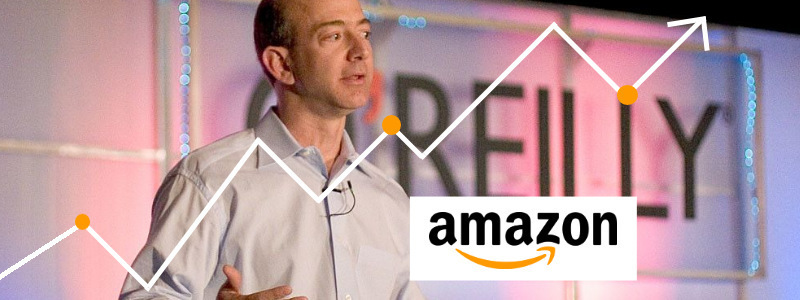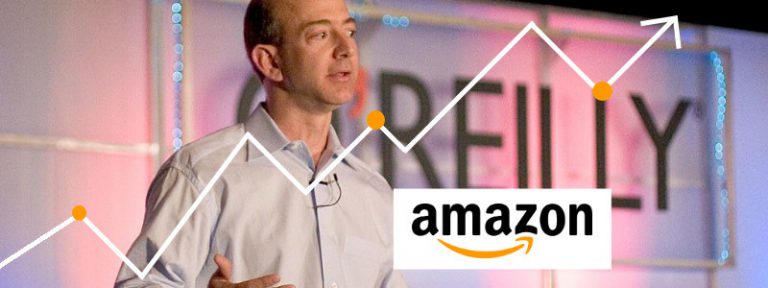Amazon is a business that needs little introduction. With a reported 103 million Amazon Prime subscribers, and a whopping 4000 items sold every minute, it dominates the online selling market. Amazon’s founder, Jeff Bezos, started it as a book selling marketplace 26 years ago, and has since become the richest man in the world. We’re breaking down some of the decisions behind Amazon’s success, and what you can take away from that as a business owner.
Goal in setting up Amazon
Amazon, originally named Cadabra, was created as an online bookstore, and transitioned to selling music and movies as consumer interest grew. Bezos’ goal in creating a business like Amazon was to utilise the Internet before people took it seriously; “I knew when I was 80 I wouldn’t regret trying to participate in this ‘thing’ called the Internet, which I knew was going to be a big deal. I knew that if I failed, I wouldn’t regret it. The one thing I thought I might regret, was never having tried”
Long term growth strategy
Bezos has always had a focus on long term growth, with Amazon’s profits being rigorously re-invested to nurture this strategy. This is reported to be one of the reasons Amazon has grown so rapidly, and continued despite issues with overspending.
Bezos said, on his growth strategy: “you need a culture that high-fives small and innovative ideas and senior executives [that] encourage ideas. In order for innovative ideas to bear fruit, companies need to be willing to wait for 5-7 years, and most companies don’t take that time horizon.”
The strategy for long term growth – in the mind of Bezos – is contained to a 4-pillar strategy. These 4 pillars are: customer centric, innovation, corporate agility and continual optimisation.
- Pillar 1 – Customer centric
Instead of focusing solely on keeping ahead of your competitors, focus on keeping ahead of your customers. Bezos uses this approach throughout his decisions resolving Amazon, and most notably has an active email that customers can email. If a customer has issues with their product, or the service they received, they can email jeff@amazon.com to get directly to him. Bezos doesn’t respond to emails, but will forward certain emails to the employee in question with a “?” as the only comment. Employees then reportedly treat this like a ticking time bomb, and will have to find out why the issue occurred, and the resolution, as quickly as possible. This continually drives the point home that customer experiences are one of the most important parts of Amazon’s success. - Pillar 2 – Innovation
This is focusing on creating products or services that truly benefit consumers. Innovation for the sake of it is discouraged, and your focus should be entirely on evaluating the needs of customers, and then working out how to achieve that; “there are two ways to extend a business. Take inventory of what you’re good at and extend out from your skills. Or determine what your customers need and work backward, even if it requires learning new skills. Kindle is an example of working backward.” - Pillar 3 – Corporate agility
Bezos talks a lot about remaining agile when operating a business. You need to know when to switch things up, and be willing to change parts of your business model to remain agile, and competitive; “the thing about inventing is you have to be both stubborn and flexible. The hard part is figuring out when to be which.” - Pillar 4 – Continual optimisation
The final pillar is continuous optimisation. Everything from the way you package your products, down to the way you manage staff absences can be optimised, over and over again.
Takeaways for businesses today
- Celebrate the small goals. Back in 1994 when Amazon sold only books, a bell was set up to ring each time an order was placed, and the team gathered round to see if they recognised the customer that ordered. They had to turn the bell off once orders started to increase, and it was ringing a lot more frequently, but the lesson still remains: celebrate business goals, no matter how small they are. It doesn’t have to come in the form of a bell ring with every order, but could be something as small as a business wide notification of every order or sale, or every X amount of orders, if you receive high quantities.
- Take chances on your gut instincts. Bezos took a chance on his gut instinct; that the Internet was going to take off and become the next big thing. He constructed the plan for Amazon on a cross-country road trip from New York City to Seattle, and got straight to work implementing his vision.
- Treat employees fairly. Amazon has received a lot of backlash for their rumoured mistreatment of employees. Alongside this, Bezos has a well-known 2 pizza rule, which states that teams should be no bigger than 10, because that is the perfect amount of employees to be satisfied with a 2 pizza meal. While this has gained notoriety for being a popular productivity management tool, some sources have said that many Amazon staff hated this rule, and find it adds high levels of pressure to their team. This is a drastic example of a company achieving massive amounts of productivity, but at the cost of potentially losing quality staff members due to overworking and unrealistic goals. Focus on ensuring your staff members have a good work-life balance, are treated fairly and are satisfied at work.


